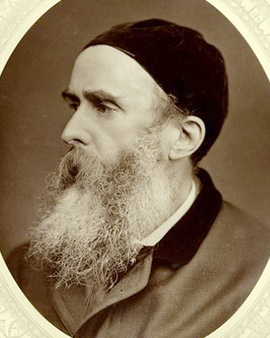A blustery day on the Irish coast, a fisherman with a weather-beaten face, children playing on the beach - such scenes are typical of Erskine Nicol's work. His paintings capture the everyday life of ordinary people in the 19th century with a rare blend of empathy, humor, and social awareness. Born in 1825 in Leith, Scotland, Nicol became especially known for his depictions of Irish and Scottish scenes, which he rendered with a keen eye for detail and human gesture. His works reflect the social upheavals and challenges of the time, particularly the effects of the Irish famine and the resulting social tensions. Nicol was a master at juxtaposing the tragic and the comic aspects of life without ever lapsing into sentimentality. Instead, he created images that provoke thought and draw the viewer into the depicted situations.
His style is characterized by realism, with Nicol always striving for an accurate observation of reality. The color palette of his paintings is often warm and earthy, lending the depicted scenes a special authenticity. Particularly striking is his ability to capture light and atmosphere, giving his works a vivid presence. Nicol was a member of the Royal Scottish Academy and exhibited regularly in London and Edinburgh. His influence on 19th-century British genre painting is unmistakable, and his works are now found in numerous museums and collections. Despite his success, Nicol remained closely connected to the simple life and the people he painted. His art stands as a powerful testament to the ability of painting to make social realities visible and to evoke empathy.
×





.jpg)
.jpg)
.jpg)
.jpg)
.jpg)
.jpg)
.jpg)
.jpg)
.jpg)
.jpg)
.jpg)
.jpg)
.jpg)
.jpg)
.jpg)
.jpg)
.jpg)
.jpg)
.jpg)
.jpg)
.jpg)
.jpg)
.jpg)
.jpg)
.jpg)
.jpg)
.jpg)
.jpg)
.jpg)
.jpg)
.jpg)
.jpg)
.jpg)
.jpg)
.jpg)
.jpg)
.jpg)
.jpg)
.jpg)
.jpg)
.jpg)
.jpg)
.jpg)
.jpg)
_-_(MeisterDrucke-1628479).jpg)
_-_(MeisterDrucke-1628479).jpg)
_-_(MeisterDrucke-979262).jpg)
_-_(MeisterDrucke-979262).jpg)
.jpg)
.jpg)
_-_(MeisterDrucke-1627882).jpg)
_-_(MeisterDrucke-1627882).jpg)
.jpg)
.jpg)
.jpg)
.jpg)
.jpg)
.jpg)
.jpg)
.jpg)
.jpg)
.jpg)
_-_(MeisterDrucke-1633997).jpg)
_-_(MeisterDrucke-1633997).jpg)
.jpg)
.jpg)
.jpg)
.jpg)
_-_(MeisterDrucke-1112802).jpg)
_-_(MeisterDrucke-1112802).jpg)
.jpg)
.jpg)
_-_(MeisterDrucke-1628458).jpg)
_-_(MeisterDrucke-1628458).jpg)
.jpg)
.jpg)
_-_(MeisterDrucke-1638104).jpg)
_-_(MeisterDrucke-1638104).jpg)
_-_(MeisterDrucke-1633327).jpg)
_-_(MeisterDrucke-1633327).jpg)
_-_(MeisterDrucke-1633810).jpg)
_-_(MeisterDrucke-1633810).jpg)
.jpg)
.jpg)
_-_(MeisterDrucke-1633329).jpg)
_-_(MeisterDrucke-1633329).jpg)
.jpg)
.jpg)
_-_(MeisterDrucke-1628456).jpg)
_-_(MeisterDrucke-1628456).jpg)
.jpg)
.jpg)
_-_(MeisterDrucke-1634897).jpg)
_-_(MeisterDrucke-1634897).jpg)
.jpg)
.jpg)
_-_(MeisterDrucke-1633328).jpg)
_-_(MeisterDrucke-1633328).jpg)
_-_(MeisterDrucke-1638105).jpg)
_-_(MeisterDrucke-1638105).jpg)
_-_(MeisterDrucke-1627881).jpg)
_-_(MeisterDrucke-1627881).jpg)
.jpg)
.jpg)
_-_(MeisterDrucke-1628457).jpg)
_-_(MeisterDrucke-1628457).jpg)
_-_(MeisterDrucke-1633809).jpg)
_-_(MeisterDrucke-1633809).jpg)
_-_(MeisterDrucke-1634898).jpg)
_-_(MeisterDrucke-1634898).jpg)






